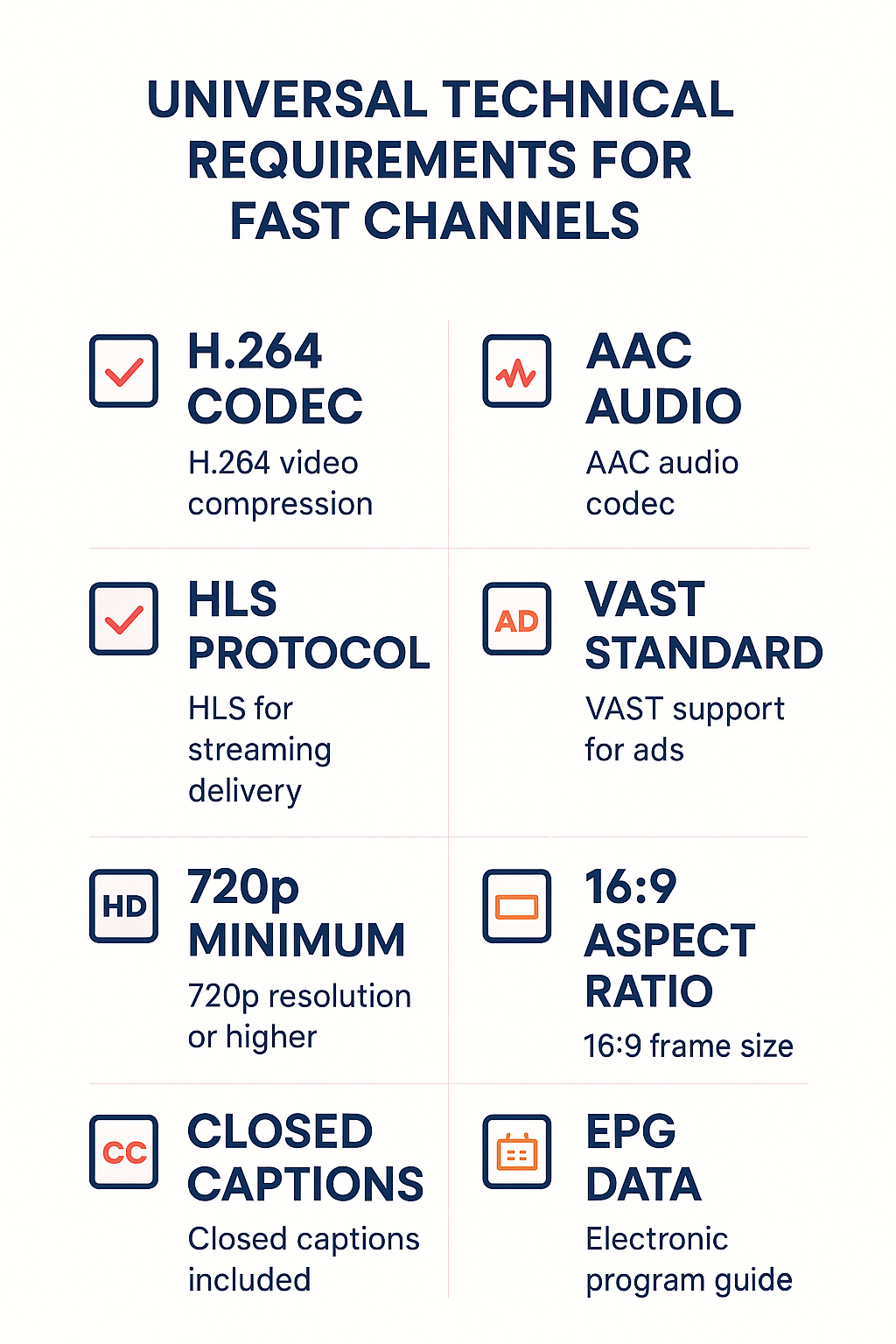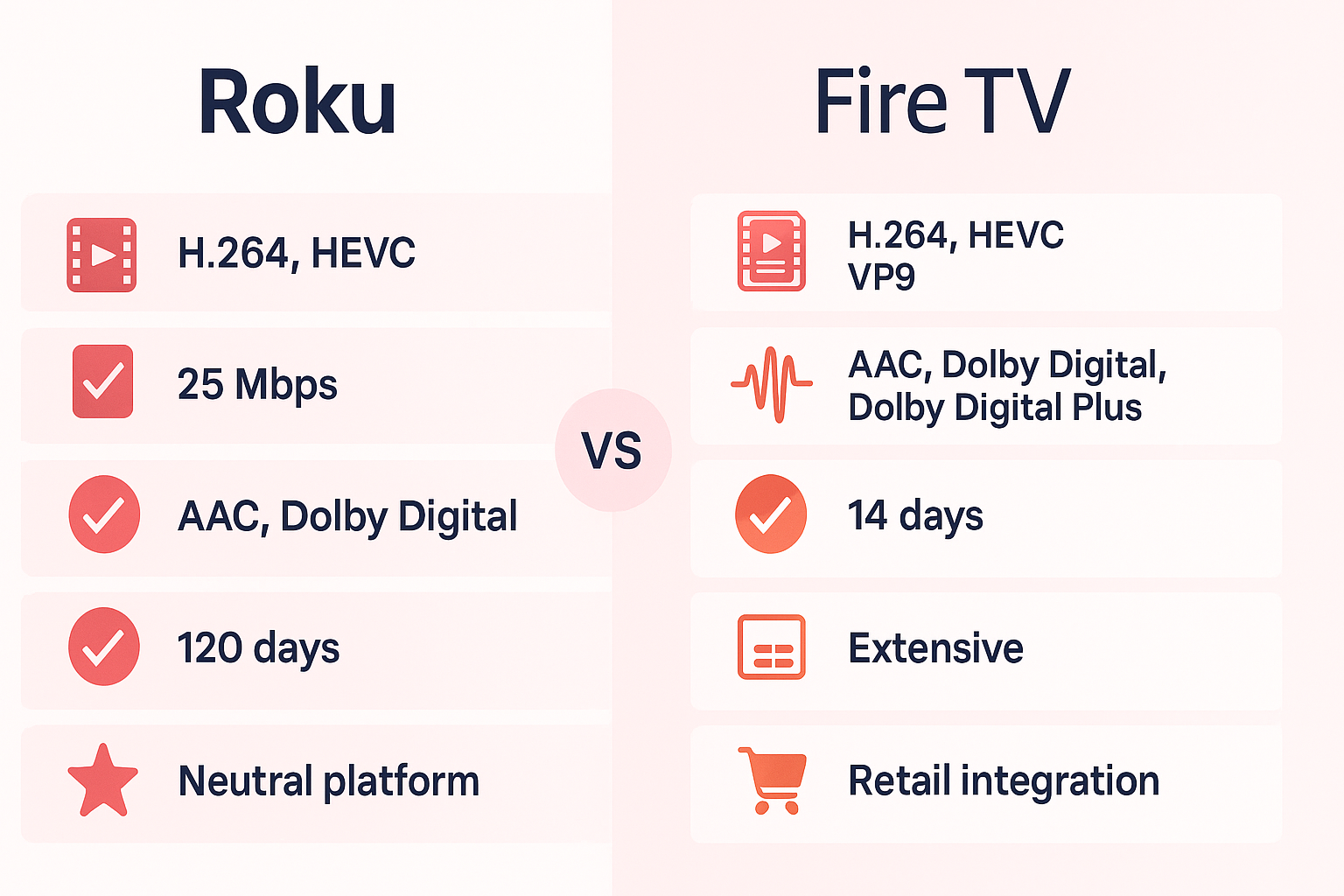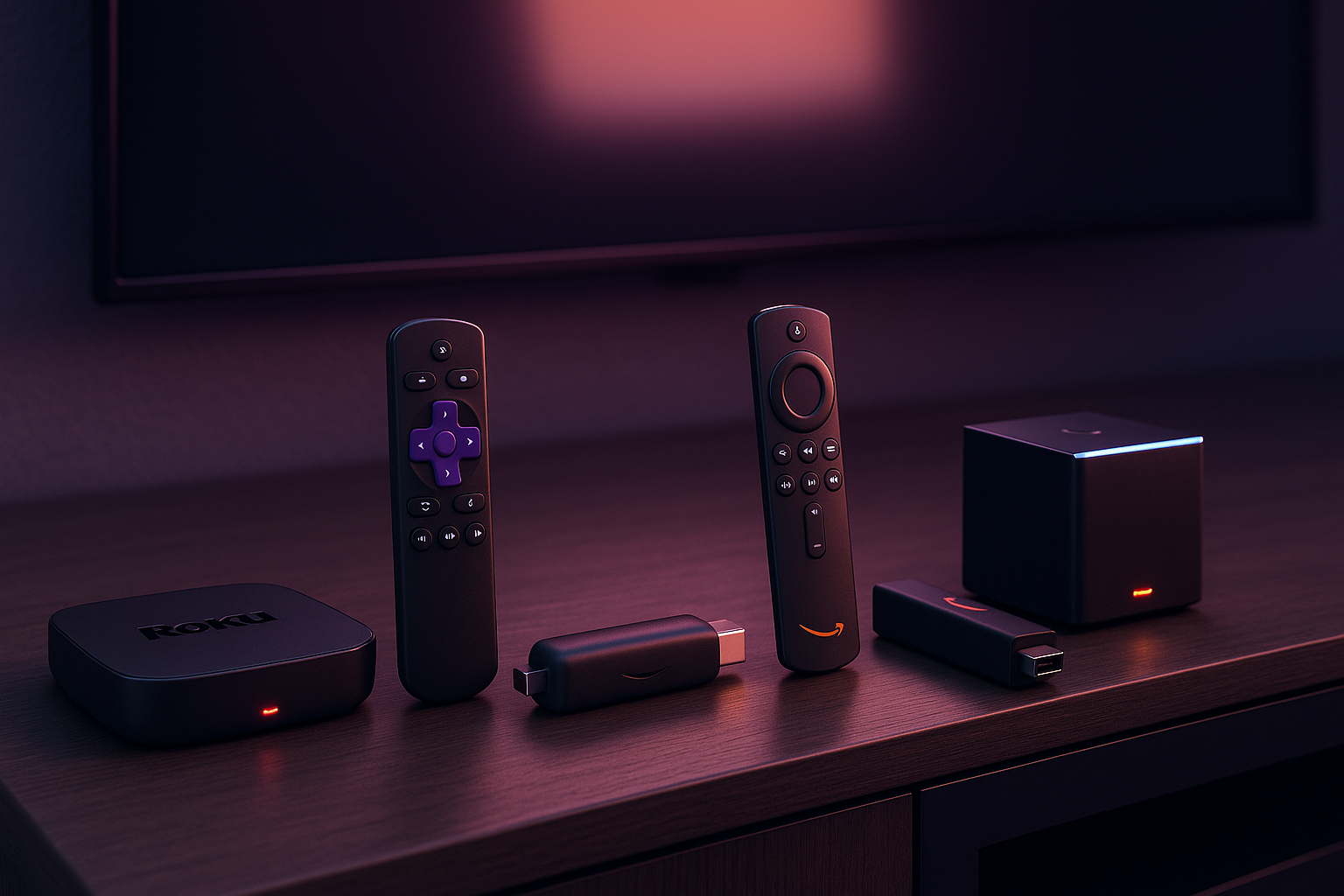Part 1: FAST Channel Technical Specifications Series
Universal Technical Requirements
Building a FAST channel that works reliably across platforms isn’t optional—it’s essential. Whilst each streaming platform has unique quirks and preferences, there exists a core set of technical specifications that every platform demands. These universal requirements form the foundation of successful FAST channel distribution, and getting them right from the start saves countless hours of troubleshooting and platform rejections later.
Understanding these baseline specifications ensures your channel can reach the widest possible audience whilst maintaining the quality standards that keep viewers engaged. Publishers who master these fundamentals position themselves for rapid platform expansion, whilst those who ignore them find themselves trapped in endless technical reviews and certification delays.

Video Codec Standards: The Non-Negotiables
Every major FAST platform requires H.264/AVC as the baseline video codec (https://iabtechlab.com/standards/video/). This isn’t negotiable. H.264 has achieved near-universal compatibility across devices manufactured since 2010, making it the safe harbour for content delivery. The codec delivers excellent compression efficiency, reducing file sizes by up to 50% compared to older MPEG-2 standards whilst maintaining visual quality that satisfies viewer expectations.
For publishers targeting premium 4K content delivery, H.265/HEVC offers substantially better compression—up to 50% better data compression at the same level of video quality compared to H.264 (https://getstream.io/glossary/hevc/). However, HEVC adoption requires careful consideration. Support varies significantly across older devices, and licensing costs can become complex for commercial implementations. Most successful FAST channels maintain H.264 as their primary delivery format whilst offering HEVC as an optional enhancement for compatible devices.
The practical bitrate targets for H.264 encoding depend entirely on your content’s resolution. For 1080p content, maintain bitrates between 3.5 and 5 Mbps for optimal quality-to-bandwidth ratio. Content at 720p functions well between 2 and 3 Mbps, whilst SD content (480p) should target 800 Kbps to 1.5 Mbps. These recommendations balance visual quality against buffering concerns, ensuring smooth playback even when network conditions fluctuate (https://arstech.net/video-encoding-bitrates-for-4k-and-1080p-with-h-264-and-h-265/).
Audio Requirements That Actually Matter
Audio specifications receive far less attention than video requirements, yet poor audio implementation causes just as many platform rejections. AAC-LC remains the universal standard, with stereo output at 128 kbps providing excellent quality for the vast majority of content. Platforms expect audio sampling rates of 48 kHz, though 44.1 kHz typically functions without issues.
Multichannel audio support varies dramatically between platforms. Publishers with premium content featuring 5.1 surround sound should encode in Dolby Digital Plus (E-AC3) whenever possible (https://sdkdocs-archive.roku.com/Audio-and-Video-Support_3737490.html). However, always provide a stereo AAC fallback track—many platforms and devices cannot decode multichannel audio, and without a stereo alternative, these viewers experience complete audio failure.
Audio normalisation prevents jarring volume changes between content and advertisements. Target -23 LUFS for your content audio, matching industry standards for broadcast television. This creates a consistent viewer experience that reduces complaints about ads being significantly louder than programming—a common issue that drives viewers away from ad-supported platforms.
HLS Protocol: Your Streaming Foundation
HTTP Live Streaming (HLS) has become the de facto standard for FAST channel delivery (https://developer.apple.com/streaming/). Originally developed by Apple, HLS now enjoys support across virtually every streaming platform and device. The protocol breaks your video stream into small segments—typically 6 to 10 seconds each—allowing players to adapt quality dynamically based on available bandwidth.
Creating an effective HLS implementation requires generating multiple quality variants. A robust ladder includes at least four renditions: 360p at 600 Kbps (minimum quality for poor connections), 480p at 1.2 Mbps (baseline mobile quality), 720p at 2.5 Mbps (HD quality for most viewers), and 1080p at 4.5 Mbps (premium quality for excellent connections). This ladder ensures your content remains accessible regardless of viewer connection quality.
Segment duration directly impacts your channel’s behaviour. Shorter segments (4 to 6 seconds) enable faster quality switching and reduced initial buffering, improving the viewer experience on mobile devices and unstable connections. Longer segments (8 to 10 seconds) reduce HTTP overhead and improve encoding efficiency, making them preferable for stable, high-bandwidth environments like connected televisions.
Advertising Standards: VAST and the Modern Reality
The Interactive Advertising Bureau’s Video Ad Serving Template (VAST) provides the framework for ad delivery across FAST platforms (https://www.iab.com/guidelines/digital-video-ad-format-guidelines/). VAST 4.x represents the current standard, though many platforms continue supporting VAST 3.0 for backwards compatibility. Publishers should implement VAST 4.x wherever possible to access improved error reporting and verification features.
VPAID (Video Player Ad-Serving Interface Definition) once promised revolutionary interactive advertising capabilities, but the industry has largely moved away from this standard (https://setupad.com/blog/vpaid-vs-vast/). VPAID introduced significant security concerns, created performance issues on mobile devices, and caused extended ad load times that frustrated viewers. Modern FAST platforms increasingly prefer or require simpler VAST implementations, making VPAID support less critical for new channel deployments.
Server-side ad insertion (SSAI) has emerged as the preferred implementation method for FAST channels. Unlike client-side insertion, SSAI stitches advertisements directly into your video stream on the server before delivery to viewers. This approach prevents ad blockers from interfering with monetisation, creates seamless transitions between content and advertisements, and dramatically reduces buffering issues that occur when players must fetch separate ad creative.
Metadata Requirements That Platforms Actually Enforce
Electronic Programme Guide (EPG) data quality directly correlates with viewer discovery and engagement. Every programme entry requires accurate start times, duration information, programme titles, and episode descriptions. Platforms may reject channels with incomplete or inconsistent EPG data, as this information powers their programme guides, search functions, and recommendation algorithms.
Schedule accuracy matters more than most publishers realise. Your EPG data must reflect your actual broadcast schedule with precision—mismatches between promised programming and delivered content frustrate viewers and trigger platform compliance reviews. Update your EPG data at least 7 days in advance, with absolute minimum updates 24 hours before broadcast for late-schedule changes.
Programme descriptions should provide genuine value whilst incorporating relevant keywords naturally. Avoid promotional language that reads like advertising copy—viewers and platform algorithms both recognise and penalise this approach. Focus instead on specific, informative descriptions that help viewers understand programme content and decide whether to watch.
Resolution and Aspect Ratio Fundamentals
Aspect ratio standardisation prevents the pillarboxing and letterboxing that create poor viewing experiences. Modern FAST platforms expect 16:9 content exclusively. Publishers with 4:3 legacy content must pillarbox during encoding rather than expecting platforms to handle this conversion. Inconsistent aspect ratios within a channel create jarring visual transitions that signal poor production quality to viewers.
Resolution requirements vary by platform but converge around common standards. At minimum, deliver 720p (1280×720) content—anything below this threshold faces increasing rejection from major platforms. Publishers with premium content should encode at 1080p (1920×1080) to meet viewer quality expectations, particularly for genres where visual detail matters, such as travel, nature, or dramatic series.
Interlaced content creates problems on modern progressive-scan displays and mobile devices. Always deinterlace source material during encoding. The computational cost of proper deinterlacing during encoding is negligible compared to the image quality improvements and compatibility benefits this processing provides.
Frame Rate Considerations
Frame rate selection depends on your source content and target distribution. Film content typically uses 23.976 fps, matching its theatrical origins. Video content generally employs 29.97 fps, providing smooth motion reproduction that matches broadcast television standards. Select your frame rate based on source material rather than platform requirements—conversion between frame rates introduces artefacts that degrade quality.
Sports content benefits from higher frame rates when bandwidth permits. 60 fps (59.94 fps precisely) dramatically improves motion clarity during fast action, making it valuable for live sports programming. However, the increased bitrate requirements nearly double compared to 30 fps content, so evaluate whether your target platforms and viewer connections can support this enhanced quality.
Frame rate consistency throughout your channel prevents playback issues on certain devices. Mixing 24 fps and 30 fps content within the same stream can cause sync issues, stuttering, or complete playback failures on older players. Standardise on a single frame rate for your entire channel unless your encoding and delivery infrastructure explicitly supports mixed-frame-rate content.
Closed Caption and Subtitle Standards
Accessibility requirements increasingly mandate closed captions, and platforms enforce these standards rigorously (https://www.3playmedia.com/learn/digital-accessibility/closed-captioning-vs-subtitles/). WebVTT has emerged as the preferred caption format for HLS delivery, offering straightforward implementation and broad device support. Ensure your captions include position, styling, and timing information that creates readable text without obscuring critical on-screen action.
Caption quality reflects on your brand and affects viewer satisfaction. Automatically generated captions contain significant errors that frustrate viewers, particularly for content with technical terminology, proper names, or speakers with accents. Invest in professional caption editing—the modest cost pays dividends in viewer retention and platform compliance.
Multiple subtitle languages expand your addressable audience, particularly for platforms with international distribution. Priority should focus on Spanish and French for North American distribution, with additional languages based on your content’s international reach. Proper subtitle implementation requires native speakers for translation and cultural adaptation—direct machine translation produces results that alienate international viewers.
Quality Control Checkpoints
Implement systematic quality assurance before platform submission. Encode test files and validate playback across multiple devices representing your target audience—iOS mobile, Android tablets, Roku devices, and web browsers at minimum. Each platform exhibits unique playback behaviours, and catching incompatibilities during testing prevents rejected submissions and delayed launches.
Automated validation tools catch technical violations that human review misses. Use video analysis software to verify bitrates remain within spec, segment durations match your target, and quality ladders maintain appropriate gaps between renditions. These tools quickly identify encoding errors that would otherwise require painful manual review and reencoding.
Audio-video sync verification prevents the most frustrating viewer experience issues. Play random samples throughout your content, watching for lip-sync problems or audio that drifts ahead of or behind the video. Sync issues often arise during encoding or transcoding processes, and they must be caught before platform submission—most platforms immediately reject content with obvious sync problems.
Every successful FAST channel builds upon these universal technical requirements. Master these fundamentals, and platform-specific optimisations become straightforward incremental improvements rather than overwhelming technical challenges. Publishers who shortcut this foundation inevitably encounter rejection, rework, and delayed monetisation—the technical debt always comes due, and paying it in advance proves far less expensive.





Related news
View all


